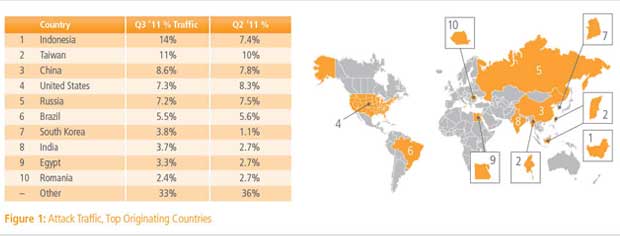- Category: February 2012 - Mobile Marketing
 Akamai recently published its quarterly "The State of the Internet" (SOTI) report that included data gathered from across the Akamai Intelligent Platform on broadband adoption, mobile connectivity, attack traffic and other relevant topics concerning the Internet and its usage, as well as trends seen in the data during this time.
Akamai recently published its quarterly "The State of the Internet" (SOTI) report that included data gathered from across the Akamai Intelligent Platform on broadband adoption, mobile connectivity, attack traffic and other relevant topics concerning the Internet and its usage, as well as trends seen in the data during this time.
Attack Traffic from Asia
During the third quarter of 2011, attack traffic originated from 195 unique countries or regions, up from 192 in the second quarter. In examining the continental distribution of observed attack traffic, Akamai discovered that slightly more than 49% originated in the Asia Pacific/Oceania region, up from 47% in the last quarter.
Indonesia vaulted to the top of the list this quarter, generating 14% of observed attack traffic. Taiwan and China held second and third place, respectively, accounting for just under 20% of observed attack traffic combined. Myanmar, which suddenly appeared at the top of the list in the prior two quarters, disappeared just as suddenly, potentially indicating that attack traffic has either been shut down, or is now coming from other places. With Myanmar dropping out of the top 10 list, South Korea moved in. The country more than tripled its observed level of attack traffic, representing 3.8% in the third quarter. In addition to South Korea and Indonesia, Taiwan, China, India, and Egypt were all responsible for higher percentages of attack traffic when compared to the prior quarter.
Attack traffic originating in Europe was down slightly to 28%; North and South America accounted for nearly 19%; and the remaining 4% came from Africa.
Top Ports for Attack Traffic
Attack traffic concentration declined slightly from the second quarter, with the top 10 ports seeing 68% of observed attack traffic. Attacks targeting Port 80 (WWW/HTTP) dropped by about a third when compared to the second quarter, while attacks targeting Port 23 (Telnet) grew by almost the same amount. The growth in attacks targeting Port 23 is likely due to attacks apparently sourced in Egypt and South Korea - in Egypt there were over 18 times as many attacks targeting Port 23, and in South Korea, nearly four times as many attacks as the next most targeted port, which was Port 445 for both countries.
Reviewing observed attack traffic from known mobile networks, overall attack traffic concentration declined from the prior quarter, with the top 10 countries generating 76% of observed attacks. The list of top ports targeted remained consistent with the second quarter, with Port 445 remaining the target of an overwhelming majority of observed attacks as compared to the other ports in the top 10.
Additional highlights from the report include:
Internet and Broadband Adoption
The global average connection speed was recorded at 2.7 Mbps, and the global average peak connection speed was 11.7 Mbps. At a country level, South Korea had the highest average connection speed, at 16.7 Mbps, as well as the highest average peak connection speed, at 46.8 Mbps. Cities in Japan and South Korea continued to hold many of the top spots for highest peak connection speeds. Globally, high broadband (>5 Mbps) adoption grew to 29% with South Korea leading at 79%. Global broadband (>2 Mbps) adoption increased to 66%, with Bulgaria continuing to have the highest level of broadband adoption at 96%. Global narrowband (<256 kbps) adoption continued to decline, dropping to 2.5%. Libya’s 55% narrowband adoption rate placed it as the country with the highest level of connections in this speed range.
In the third quarter, more than 615 million unique IPv4 addresses from 239 countries/regions connected to the Akamai platform - 1.8% more than the second quarter, and 15% more than in the third quarter of 2010. Nearly 200 countries/regions saw year-over-year growth, with Brazil, Italy, and China all experiencing growth of 25% or more.
As more end-user networks roll out native IPv6 connectivity to their subscribers, and as more and more popular content is made available over IPv6, the number of unique IPv4 addresses making requests to Akamai from a given network provider should decline. Over the long-term, the company expects measurements to show movement of unique addresses from IPv4 to IPv6-based.
Mobile Connectivity
Average connection speeds on known mobile providers ranged from 6.1 Mbps down to 327 kbps, while average peak connection speeds in the quarter ranged from 22.2 Mbps to 1.4 Mbps. Looking at mobile content consumption, users on nine mobile providers consumed an average of more than one gigabyte (1 GB) of content from Akamai per month, while users on an additional 75 mobile providers downloaded more than 100 Mb of content per month. In addition, based on data collected by Ericsson, mobile data traffic continued to double on a year-over-year basis, and grew 18% between the second and third quarters of 2011.
100 Fastest Cities Worldwide
In the third quarter of 2011, analysis of the top 100 fastest cities around the world, based on average connection speeds, reflected the following:
- Cities in Asia continue to dominate the list, including South Korean cities rounding out the top five and 57 cities in Japan making the list
- Amsterdam, Netherlands is the fastest city in Europe (#33 out of 100)
- 23 US cities made the list, with San Jose, CA ranking as the fastest (#13 out of 100)
A few highlights from the report include:
Connection speeds
- Among the 100 fastest cities worldwide, cities in Asia continue to dominate the list, including South Korean cities rounding out the top five and 57 cities in Japan making the list
- South Korea had the highest average connection speed, at 16.7 Mbps, as well as the highest average peak connection speed, at 46.8 Mbps
- Singapore ranked fourth on table and 33rd in the world with 4.5 Mbs (broadband)
- Based on data collected by Ericsson, mobile data traffic continued to double on a year-over-year basis, and grew 18% between the second and third quarters of 2011
Narrowband connectivity
- Countries in the region experienced decline with losses of more than 50% in Taiwan and Singapore
- An unusually large quarterly increase was seen in Thailand – probably due to the massive and widespread flooding that occurred there in Q3 2011
- South Korea saw increase year-over-year but still retains scant adoption rate at 0.3% (just over 61,000 unique IP addresses connecting to Akamai at speeds below 256bps)
Connection speeds/data consumption on mobile networks
- A provider in Singapore saw average peak connection speeds grow by more than 100% quarter-over-quarter
- A carrier in Thailand posted strong growth in content download volume - this may point to more Thais relying more heavily on their mobile devices for Web-based communications and to obtain critical information during their time of crisis
Attack traffic
- Indonesia became the top attack traffic source, accounting for 14% of observed attack traffic in total
- Taiwan and China held second and third place, respectively, accounting for just under 20% of observed attack traffic combined



